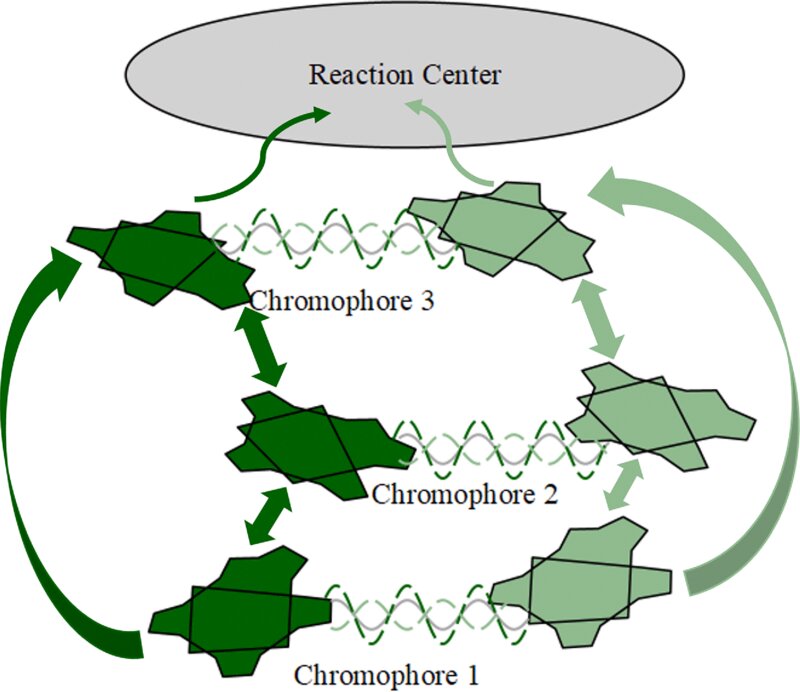科学家发现光合作用与’物质第五态’之间的联系
诸平
Two pathways represented by the two sites of each chromophore. When ξ=0 , there is no cross-site interchromophore coupling, as shown. When V>0 , there is coupling, resulting in quantum interference between the sites of each chromophore. The waves demonstrate that the quantum interference can be either constructive or destructive, with constructive interference enhancing the energy-transfer efficiency. Credit: PRX Energy (2023). DOI: 10.1103/PRXEnergy.2.023002
据美国芝加哥大学(University of Chicago, Chicago, Illinois, USA)2023年5月3日提供的消息,该校科学家发现光合作用与’物质第五态’之间的联系(Scientists find link between photosynthesis and 'fifth state of matter')。
在实验室里,科学家们惊奇地发现,当原子冷却到接近绝对零度时,会形成一种奇怪的状态。在他们的窗外,树木收集阳光并将它们变成新叶。这两者似乎无关,但美国芝加哥大学的一项新研究表明,这些过程并不像表面上看起来那么不同。相关研究结果于2023年4月28日已经在《PRX能源》(PRX Energy)杂志网站发表——Anna O. Schouten, LeeAnn M. Sager-Smith, David A. Mazziotti. Exciton-Condensate-Like Amplification of Energy Transport in Light Harvesting, PRX Energy, 2023, 2: 023002. DOI: 10.1103/PRXEnergy.2.023002. Published 28 April 2023. https://doi.org/10.1103/PRXEnergy.2.023002
此研究发现,在原子水平上,光合作用和激子凝聚物(exciton condensates)之间存在联系,这是一种奇怪的物理状态,可以让能量在材料中无摩擦地流动。作者说,这一发现在科学上很有趣,可能为设计电子产品提供了新的思路。
“据我们所知,这些领域以前从未联系过,所以我们发现这非常引人注目和令人兴奋,”研究合著者大卫·马齐奥蒂教授(Prof. David Mazziotti)说。
大卫·马齐奥蒂的实验室专门研究原子和分子之间复杂的相互作用,因为它们显示出有趣的特性。用肉眼无法看到这些相互作用,因此计算机建模可以为科学家提供一个了解行为发生原因的窗口,也可以为设计未来的技术提供基础。
特别是,大卫·马齐奥蒂和研究的合著者安娜·斯考滕(Anna Schouten)和李安·扎格尔-斯密斯(LeeAnn Sager-Smith)一直在模拟光合作用发生时在分子水平上发生的事情。
当来自太阳的光子照射到叶子上时,它会在一种特殊设计的分子中引发变化。其能量释放出一个电子。电子和它曾经所在的“空穴”现在可以在叶子周围移动,将太阳的能量带到另一个区域,在那里它引发化学反应,为植物制造糖类物质。
电子和空穴对一起被称为“激子”("exciton")。当研究团队鸟瞰并模拟多个激子如何移动时,他们注意到一些奇怪的事情。他们在激子的路径中看到了非常熟悉的模式。
事实上,它看起来非常像一种被称为玻色-爱因斯坦凝聚物(Bose-Einstein condensate)——有时也被称为“物质的第五态”("the fifth state of matter")的物质的行为。在这种材料中,激子可以连接成相同的量子态,就像一组铃声一样,所有的铃声都完美地响起。这使得能量可以零摩擦地在材料周围移动。这些奇怪的行为引起了科学家们的兴趣,因为它们可能是非凡技术的种子,例如,一种类似的被称为超导的状态是核磁共振成像机器(MRI machines)的基础。
根据安娜·斯考滕、李安·扎格尔-斯密斯和大卫·马齐奥蒂创建的模型,叶子中的激子有时可以以类似于激子凝聚物行为的方式连接起来。
这是一个巨大的惊喜。激子凝聚物(exciton condensates)只有在材料冷却到明显低于室温时才会出现。这有点像在一杯热咖啡中看到冰块形成。
安娜·斯考滕解释说:“光合作用的光收集发生在室温下的系统中,而且,它的结构是无序的,与原始结晶材料和用于制造激子凝聚物的低温非常不同。”
科学家们说,这种影响并不是完全的,它更类似于凝聚物形成的“岛屿”。“但这仍然足以增强系统中的能量传递,”李安·扎格尔-斯密斯说。事实上,他们的模型表明,它可以将效率提高一倍。
大卫·马齐奥蒂说,这为未来技术生产合成材料开辟了一些新的可能性。“一个完美的理想激子凝聚物是敏感的,需要很多特殊的条件,但对于实际应用来说,看到一些可以在环境条件下提高效率的东西是令人兴奋的。
大卫·马齐奥蒂说,这一发现也符合他的团队十年来一直在探索的更广泛的方法。
在光合作用等过程中,原子和分子之间的相互作用是非常复杂的,即使是超级计算机也很难处理,所以科学家们传统上不得不简化他们的模型,以便掌握它们。但大卫·马齐奥蒂认为有些部分需要保留:“我们认为电子的局部相关对于捕捉大自然的实际运作方式至关重要。”
Scientists predict state of matter that can conduct both electricity and energy perfectly
上述介绍,仅供参考。欲了解更多信息,敬请注意浏览原文或者相关报道。
All around us, green leaves capture energy from the sun. Meanwhile, physical phenomena, like superconductivity, are considered to be exotic. Here, the authors establish a link between these two seemingly unrelated phenomena and provide deep insight into energy transfer in quantum molecules and materials. A light-harvesting complex that occurs in green-sulfur bacteria is modeled to show that excitations in the complex, known as excitons, exhibit the beginnings of a condensation into a coherent quantum state. The single quantum state means that the excitons are working in concert to transfer energy with less friction-like loss. The exciton-like-condensation is associated with as much as a one hundred percent enhancement of the energy transfer in the light-harvesting system. These results can benefit design principles for energy transfer in quantum molecules and materials, which are important for realizing higher energy efficiency in devices with applications ranging from solar cells to computers.
Bose-Einstein condensation of excitons, in which excitons condense into a single coherent quantum state, known as an exciton condensate, enables frictionless energy transfer, but typically occurs under extreme conditions in highly ordered materials, such as graphene double layers. In contrast, photosynthetic light-harvesting complexes demonstrate extremely efficient transfer of energy in disordered systems under ambient conditions. Here, we establish a link between the two phenomena by investigating the potential for exciton-condensate-like amplification of energy transport in room-temperature light harvesting. Using a model of the Fenna-Matthews-Olson complex and accounting for intrachromophore electron correlation explicitly through the addition of multiple sites to the individual chromophores, we observe amplification of the exciton population in the particle-hole reduced density matrix through an exciton-condensate-like mechanism. The exciton-condensate-like amplification evolves with the dynamics of exciton transfer, and the nature of amplification is influenced by intra- and interchromophore entanglement, as well as the initial excitation model and number of sites per chromophore. Tuning intrachromophore coupling also increases the rate of exciton transfer with a maximum enhancement of nearly 100%. The research provides fundamental connections between exciton condensation and exciton transport in light-harvesting complexes with potential applications for harnessing the exciton-condensate-like mechanism to enhance energy transfer in synthetic systems and create new materials capable of highly efficient energy transfer.
转载本文请联系原作者获取授权,同时请注明本文来自诸平科学网博客。
链接地址:https://wap.sciencenet.cn/blog-212210-1387089.html?mobile=1
收藏


